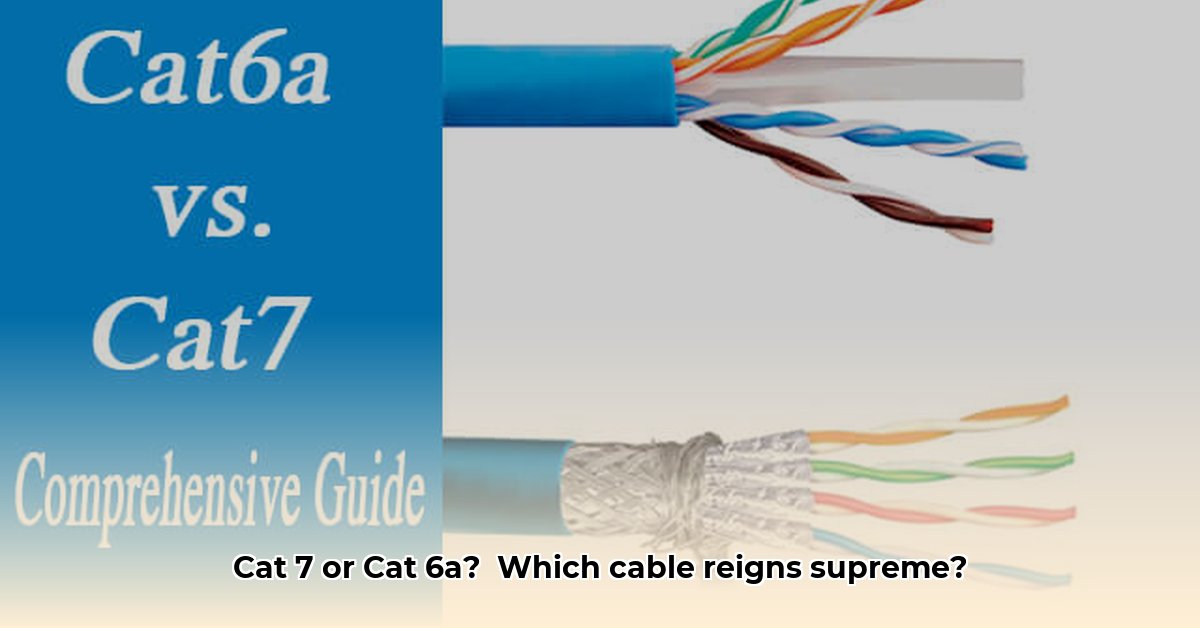Choosing the right Ethernet cable can feel like navigating a tech maze. This guide simplifies the Cat 7 vs. Cat 6a debate, helping you find the perfect cable for your needs, whether it’s for lightning-fast gaming, smooth 4K streaming, or a robust office network.
Speed & Bandwidth: Do You Need a Data Autobahn?
Both Cat 6a and Cat 7 support 10 Gigabit Ethernet (10 Gbps) over standard 100-meter lengths—plenty for most homes and offices. Think of 10 Gbps as a six-lane highway for your data. Cat 7, with its higher 600 MHz bandwidth (compared to Cat 6a’s 500 MHz), is like adding an express lane. While Cat 7 can hit higher speeds (up to 40 Gbps at 50 meters and 100 Gbps at 15 meters), these speeds aren’t standardized for longer runs. You’d also need specialized, often expensive, equipment to reach them. For everyday use, 10 Gbps is more than enough.
Shielding: Protecting Your Data from Interference
Shielding safeguards your data from electromagnetic interference (EMI). Cat 6a typically uses Shielded Twisted Pair (STP), giving each wire pair its own foil wrap. Some Cat 6a cables also have additional braiding or foil for extra protection (F/UTP or S/FTP). Cat 7 steps up the game with Screened Foiled Twisted Pair (S/FTP), adding individual foil shielding and a braided shield around the entire cable. This makes it highly resistant to EMI and crosstalk (interference between wire pairs).
| Feature | Cat 6a | Cat 7 |
|---|---|---|
| Shielding Type | Typically STP, sometimes F/UTP or S/FTP | S/FTP |
| EMI Protection | Good | Excellent |
| Crosstalk Protection | Good | Excellent |
Cost: Balancing Performance and Budget
Cat 7 carries a significantly higher price tag than Cat 6a, sometimes double or even triple the cost. For most home users, this premium isn’t justified. Cat 6a delivers excellent performance at a fraction of the price.
Standardization: Playing by the Rules
Cat 6a is fully standardized by the TIA/EIA, ensuring compatibility and reliability. Cat 7’s higher speeds, however, lack full standardization, potentially leading to compatibility issues.
Future-Proofing: Gazing into the Crystal Ball
While Cat 7 boasts higher theoretical speeds, technology evolves rapidly. Emerging standards like Cat 8 are already on the horizon. Focus on a high-quality Cat 6a installation, as it likely meets current and near-future needs for most users. Ongoing research suggests this approach may be more practical than investing in potentially underutilized Cat 7 capabilities.
Use Cases: Matching the Cable to the Task
| Scenario | Recommended Cable | Why? |
|---|---|---|
| Home Network | Cat 6a | Excellent performance for streaming, gaming, general use |
| Small Office | Cat 6a | Cost-effective and sufficient for most office needs |
| Large Enterprise/Data Center | Cat 7 | Superior shielding and potential for high speeds (with appropriate hardware). Short connections within the data center may especially benefit. |
| Industrial Setting | Cat 7 | Enhanced shielding against EMI from heavy machinery |
FAQs: Quick Answers to Common Questions
- Is Cat 7 better for gaming? Cat 6a is more than sufficient for most gamers. The benefits of Cat 7 are unlikely to be noticeable.
- How much more expensive is Cat 7? Cat 7 can cost two to three times more than Cat 6a.
- Is Cat 7 worth it? For most home and small office users, Cat 6a offers the best balance of performance and price. Cat 7 is generally only necessary for specialized environments with high EMI or demanding bandwidth requirements.
The Verdict: Choosing Your Champion
Cat 6a is the practical choice for most. It balances performance, affordability, and standardization beautifully. Cat 7 is reserved for specific high-bandwidth needs and environments with significant EMI where that premium shielding is truly valuable. Choose the cable that fits your specific needs and budget – don’t pay for performance you won’t use.
- How to Stop Apps From Running in the Background to Boost Your - December 1, 2025
- How To Move Apps On Your Droid For Better Organization - November 30, 2025
- How to Move Apps on Android for Better Organization - November 29, 2025










